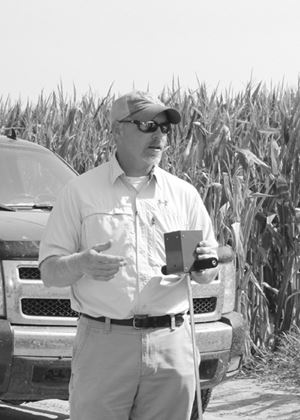Moisture Sensors Are Key Part Of Efficient Irrigation
MISSISSIPPI STATE, MISS.
If Jason Krutz could put one item on the Christmas list of every row
crop farmer in Mississippi, Santa’s elves could not make enough soil
moisture sensors to keep up with demand.
Krutz, Mississippi State University irrigation specialist at the
Delta Research and Extension Center in Stoneville, wants producers
everywhere to approach irrigation with scientific accuracy.
“We’ve been charged by you to make you better irrigators, and the
only way we think we can do that is to have you purchase soil moisture
sensors and put them in the field,” Krutz told about 400 producers, crop
consultants and specialists at the 2013 MSU Row Crops Short Course.
“It’s the only way that we can feasibly make you better irrigators.”

Jason Krutz, an irrigation
specialist with Mississippi State University, holds a portable soil
moisture meter, one of the tools needed to help producers make
irrigation decisions with scientific accuracy.
Photo by MSU Ag Communications/Bonnie Coblentz
Krutz works with the MSU Extension Service and the Mississippi
Agricultural and Forestry Experiment Station to support growers with
their irrigation needs.
“Up and down the U.S., we irrigate willy-nilly,” Krutz said. “We use a
screwdriver to dig down, kick the bed with our boots, maybe take a
shovel out and go a few inches deep to look for soil moisture. That’s
not going to cut it in the future when we’re running out of water not
only in Mississippi but around the globe.”
To both research and demonstrate irrigation efficiency, Krutz uses
the Row-crop Irrigation Science and Extension Research, or RISER,
program. Through RISER, MSU scientists partner with corn, cotton,
soybean and rice producers using existing on-farm management systems to
promote good irrigation management practices.
“I’d go to a farmer and say, ‘You give us a 40-acre field and you
keep a 40-acre field.’ I have the farmer irrigate according to his
regular decision-making process, and I use the tools we have to
determine when it was time for irrigation,” Krutz explained.
Fifteen Mississippi producers took part in the RISER program in 2013.
In each case, both fields showed similar yields, but the MSU-controlled
field used from a quarter to half as much water as the neighboring plot
irrigated using traditional decision-making processes.
“It sounds absurd to say that you can apply half the water you
normally apply and we can maintain or improve your yield almost
guaranteed and improve your profitability by cutting way down on your
water cost,” Krutz said.
The tools to make this happen, Krutz said, are soil moisture sensors,
surge irrigation and the computerized program Pipe Hole and Universal
Crown Evaluation Tool. Known as PHAUCET, this program calculates the
proper hole size and distribution for polypipe to furrow irrigate row
crops efficiently.
Tom Eubank, an Extension soybean agronomist and MAFES researcher in
Stoneville, has evaluated PHAUCET for four years under a grant from the
Mississippi Soybean Promotion Board.
“Our research has shown that PHAUCET reduces water, fuel and
irrigation usage by 20 percent versus conventional irrigation sets in
regular-shaped fields,” Eubank said. “In irregular-shaped fields,
PHAUCET could reduce water use as much as 50 percent.”
Krutz said furrow irrigation controlled by PHAUCET that uses surge
valves is the most efficient form of irrigation in the Delta. Surge
values increase irrigation efficiency by evening the distribution of
water across a field.
“If you are operating in the Delta and using polypipe and not using
PHAUCET, you are leaving money on the table,” Kurtz said. “For a moment,
set aside the water use issue. This is real money, and this can save
you a lot of money. It’s that simple.”
The final tools are soil moisture sensors placed at 6, 12, 24 and 36
inches deep. These take the guesswork out of determining how much
moisture the soil has available to plants. Portable soil moisture meters
allow a producer to spot check a field at will, confirming the data
being received from the soil moisture sensors installed in the field.
“By just looking at the sensors twice a week, a producer can tell
three days in advance when they need to pull the trigger on their
irrigation,” Krutz said.
Most traditional irrigation is done on a schedule that is based on
soil type and the water demands of the crop at a particular maturity
point. Rain alters the situation, making it more difficult to properly
time the next irrigation application. Krutz said sensors allow producers
to “see” the active rooting zone and water use within that rooting zone
throughout the season.
“I promise that you will recoup the money the first season. You might
be able to do that the first time you run irrigation,” Krutz said.∆